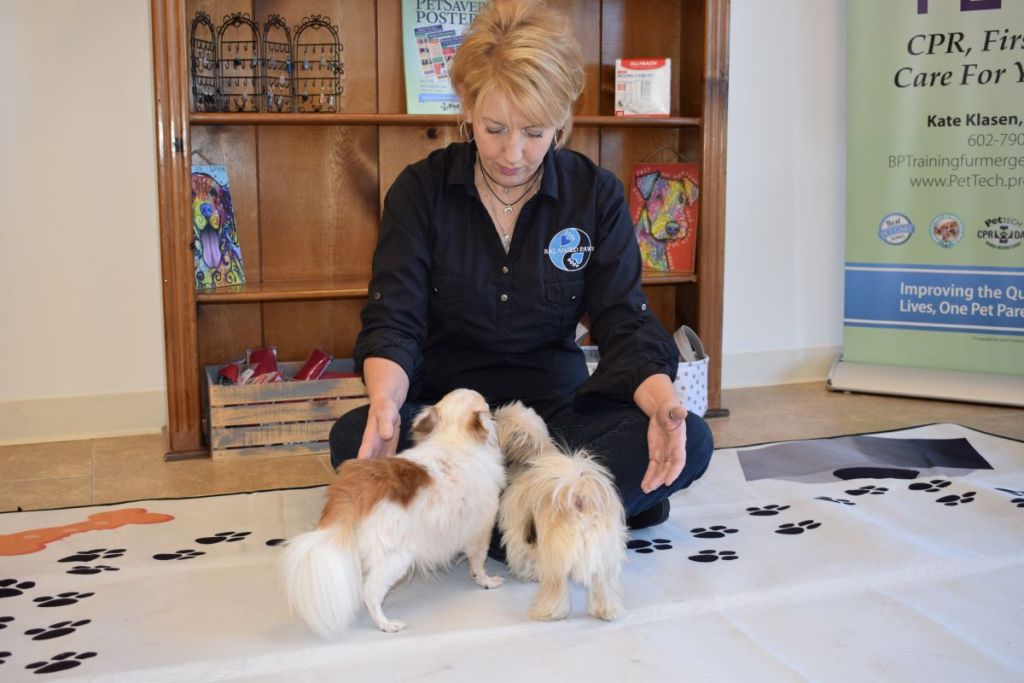As the owner of Balanced Paws Pet Spa in Fountain Hills, Arizona, Kate Klasen has never questioned the unique connection she has with animals.
“My parents were so tolerant,” she says. “Growing up, besides our family Dalmation, I had three rabbits, ten hamsters, and one box turtle all at the same time in my 8-ft. x 10-ft. bedroom.”
Not surprisingly, when she became a police officer in the Chicago suburbs, she was the one her fellow officers called whenever there was a situation involving an animal. Today, Klasen’s holistic pet grooming business uses her innate sense of empathy for animals to provide a calming experience for her clients. Many are classified as “special needs,” whose owners turn to Balanced Paws once their pets have been turned away by other groomers.
“I look at it as a total experience for the animal and not just a haircut,” she says of her pet grooming philosophy. “I try to do what I can to make it more pleasurable for them. I don’t think people realize the energy part of things and how anxiety is contagious.”
Grooming is scheduled by appointment only, with no more than two dogs in the salon at a time. Klasen uses chemical-free, cruelty-free, and artificial dye-free shampoo and moisturizing conditioner, and plays frequency-based music. When needed, she applies the ancient Japanese healing technique of Reiki to further calm and relax her more anxious clients.
About Reiki
Reiki (pronounced ray-key) is an ancient Japanese healing technique that relieves stress and pain by improving the body’s energy flow. Practitioners use a variety of hands-on, no-touch, or visualization techniques to detect physical, emotional, and spiritual problems.
Reiki is more than 2,500 years old, originating in Tibet and used by Tibetan monks. In the mid-1800s, Dr. Mikao Usui, a Japanese religious scholar who was originally intrigued by the claim that Christ could heal people by touching them with his hands, became a student of ancient religions. After having a spiritual experience in which he says he tapped into the universal life force to heal with his own hands, Dr. Usui dedicated his life to using Reiki to heal the sick and poor.
Today, Reiki students become practitioners by mastering three, sometimes four, different levels of training. Each one includes attunement (a spiritual ceremony), education, and practice. Although Reiki certification isn’t regulated, most practitioners have been trained by a Reiki Master and are also subject to the laws and regulations in their area. For example, because Reiki involves touching, some areas consider Reiki a type of massage and require practitioners to obtain the proper licenses.

How is animal Reiki different?
Although it’s difficult to determine when animal Reiki first appeared, the trend of offering holistic healing for pets is becoming more and more popular. The American Holistic Veterinary Medical Association, which formed in 1982, now has close to 1,500 members.
Holistic veterinary medicine is based on an assessment of the animal’s environment, disease pattern, and relationship with their owner in order to develop the right treatment protocols. Most integrative veterinarians use a combination of traditional Western medicine and complementary therapies like Reiki to treat their patients.
Julie Mayer, DVM CVA CVC CCRP, an integrative veterinarian and owner of Integrative Veterinarian PLLC in Phoenix, Arizona, says she began exclusively using holistic methods once she realized her patients were not being cured with traditional medicine.
“Traditional medication may have a high risk of side effects,” she explains. “When herbs, homeopathic, acupuncture, chiropractic, and Reiki are prescribed and applied, there is minimal to zero side effects.”
Klasen, who became a Reiki Master in 2016, automatically began incorporating the therapy into her grooming business. She takes animal Reiki courses from different practitioners to experience different teaching styles and techniques but believes “energy work is energy work” and is not necessarily different between humans and animals.
“Animals are sensitive,” Klasen explains. “They are more in tune with their surroundings than we are. Their senses are more heightened than ours. In my opinion, we are becoming more disassociated with each other. That brings anxiety and other issues. As a pet owner, you project it, and your pet picks up on it. I like to say, ‘It goes down the leash.’”
Does animal Reiki really work?
Becci Scott, owner of The Fetching Dog in Scottsdale, Arizona, is a self-proclaimed rescuer of special needs pets. At present, she has seven dogs, all with some sort of physical or emotional issue.
“We call our house the Misfit Inn,” she says with a laugh. “Everybody fits in here.”
Fergie was found at five weeks with front arms that were bent and would never straighten. Another, Gracie Jane, has a condition called Myotonia, with muscles that won’t relax. Lilith has Cushing’s disease. And Libby, who suffered a broken back at five months, is paralyzed from the mid-spine back.
Scott, who says she’s always had a passion for pet nutrition, meets with a lot of people who struggle to help restore their pet’s health. Several years ago, her holistic care interests caused her to cross paths with a woman who talked to her about Reiki for animals. Today, Gracie Jane benefits from the therapy.
Gracie is a mixed breed who resembles a small, white poodle and enjoys greeting visitors to The Fetching Dog, but only after making sure things are calm before she ventures out. When she starts falling a lot or seems to be tense, Scott knows it’s time to schedule a Reiki session with Klasen. She designates a quiet room at The Fetching Dog, where Gracie can lie on a soft pad atop a grooming table, and Klasen can sit beside her.
“Gracie lays there and you can see them beginning to connect,” Scott says. “Anytime I peek in, I see this incredibly stiff little dog soften so much her back legs actually come together. It’s really remarkable to see how her muscles relax and soften up. I know she is getting a deep rest that she doesn’t typically get.”

What happens in a Reiki session?
During grooming, Klasen often uses Reiki to calm a nervous client.
“Some have anxiety, so I’ll stop and take them out of that zone,” she says. “Sometimes, I just grab them and hold them and do breathing exercises. Suddenly, you can feel their body relax. Once I feel that, I can resume grooming. It takes maybe a time or two for them to realize it’s going to be different.”
During a regular Reiki session, Klasen says it usually takes a moment for the dog to realize what’s going on.
“I’ll go in and sit down and go into what looks like a meditative session,” she explains. “I let the dog dictate. If they want to be touched, they usually lay down in front of me. If not, they lie down but keep a distance. Some start out at more of a distance and end up in my lap. I let them dictate what they are comfortable with.”
She demonstrates the process with twelve-year-old Gidget, a long-haired chihuahua, and one-and-a-half-year-old Tiny Tim, a Shih Tzu mix, who peek curiously from inside their dog carriers. Tiny Tim’s back-end bones grew twisted, and Gidget is suffering from a dry cough that veterinarians can’t seem to diagnose. Together, the two weigh less than eight pounds.
Klasen sits on the floor with her legs crossed and begins to meditate, her wrists resting comfortably on her knees. Tiny Tim begins to explore the room, with Gidget close behind. Soon the two are standing perfectly still in front of Klasen, quietly soaking in the good vibes. Klasen gently places her hands on either side of Gidget, and within seconds, her cough begins to subside. Tiny Tim decides to stretch out on the floor. In a few moments, the two have had enough and walk away, so Klasen ends the session.

The science behind Reiki
Complementary and alternative medicine treatments, once considered fringe, are becoming more accepted by medical professionals. And, although the therapies remain unproven, a number of established medical facilities have begun using integrative treatments in conjunction with traditional medicine. Academic hospitals such as Yale, the University of Pennsylvania, and the Cleveland Clinic offer Reiki therapy even though no scientific evidence exists to support it.
While many traditional veterinarians have also begun integrating holistic treatments into their practices, therapies like animal Reiki should not be considered a substitute for routine veterinary care. Rather, pet parents can try them as an additional supplement to their pet’s vet visits if they and their veterinarian think it will be beneficial for the animal in question.
“It is hard to test these kinds of techniques,” Dr. Mayer explains, “but we do witness successful outcomes by observing the healing power of the treatment. Reiki can be used to treat many issues and illnesses. My patients relax and benefit from my touch.”
The response from dogs like Gracie Jane, Tiny Tim, and Gidget is evidence enough for Klasen.
“There is no placebo effect with animals,” she says. “They have no idea I’m doing a Reiki session. If an animal is responding, it’s all the proof I need to know that it actually works.”


